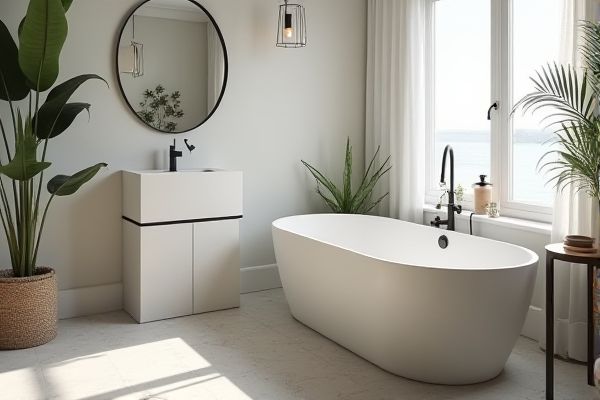
Acrylic tubs offer lightweight durability and retain heat longer, making them more comfortable for extended baths, while porcelain tubs boast a classic, glossy finish that resists scratches and stains but can be heavier and more prone to chipping. Explore the full comparison to determine which tub best suits your bathroom needs and style preferences.
Table of Comparison
| Feature | Acrylic Tub | Porcelain Tub |
|---|---|---|
| Material | Fiberglass with acrylic coating | Cast iron or steel with porcelain enamel |
| Durability | Moderate; prone to scratches | High; resistant to chips and scratches |
| Weight | Lightweight; easy to install | Heavy; may require floor reinforcement |
| Heat Retention | Moderate; cools down faster | Excellent; retains heat longer |
| Cost | Affordable; budget-friendly | Expensive; higher upfront cost |
| Maintenance | Easy to clean; avoid abrasive cleaners | Requires gentler care; can chip if struck |
| Appearance | Glossy with color options | Classic, glossy white finish |
| Lifespan | 10-15 years | 20+ years with proper care |
Acrylic Tub vs Porcelain Tub: Key Differences
Acrylic tubs are lightweight, impact-resistant, and retain heat longer, providing a warmer bath experience compared to porcelain tubs, which are heavier and more brittle due to their cast iron or steel base. Porcelain tubs feature a smooth, durable enamel surface that resists scratching and staining better than acrylic but can chip or crack upon heavy impact. Acrylic tubs offer easier installation and repair options, while porcelain tubs demand more structural support and generally come with a longer lifespan.
Material Composition and Durability
Acrylic tubs are made from a lightweight, non-porous plastic that offers excellent resistance to chipping and cracking, making them highly durable and easier to repair when damaged. Porcelain tubs consist of a cast iron or steel base coated with a porcelain enamel finish, providing a hard, glossy surface that resists scratches and stains but is prone to chipping if impacted. The durability of acrylic tubs ensures better resistance to thermal shocks and flexibility, whereas porcelain tubs deliver superior hardness and longevity but require more careful handling to maintain their finish.
Cost Comparison: Acrylic vs Porcelain Tubs
Acrylic tubs typically cost between $300 and $1,000, offering a budget-friendly option compared to porcelain tubs, which range from $500 to $2,500. Acrylic tubs are more affordable due to lower material and manufacturing expenses, while porcelain tubs incur higher costs because of their durable enamel coatings and labor-intensive production. Homeowners should weigh initial price differences against long-term durability and maintenance when choosing between acrylic and porcelain tubs.
Installation Process: Which Is Easier?
Acrylic tubs are generally easier to install due to their lightweight construction and flexibility, allowing for quicker adjustments and simpler handling compared to porcelain tubs. Porcelain tubs are significantly heavier and more fragile, requiring specialized equipment and professional expertise to avoid damage during installation. The installation process for acrylic tubs typically involves fewer steps and can be completed faster, making it a more convenient option for both DIY enthusiasts and contractors.
Comfort and Heat Retention
Acrylic tubs provide superior comfort due to their warmer surface and slight flexibility, which creates a more cushioned feel compared to the hard, cold surface of porcelain tubs. Acrylic material excels in heat retention, keeping bathwater warm for a longer period, enhancing the soaking experience. Porcelain tubs, typically made of cast iron or steel, cool down quickly, leading to faster heat loss during use.
Maintenance and Cleaning Requirements
Acrylic tubs require gentle cleaning with non-abrasive, mild cleaners to prevent scratching and maintain their glossy finish, while porcelain tubs can withstand stronger cleaning agents but are more prone to chipping and staining. Acrylic resists mold and mildew better due to its non-porous surface, reducing the frequency of deep cleaning compared to porcelain's porous enamel coating. Routine maintenance of acrylic tubs involves wiping dry after use to preserve appearance, whereas porcelain tubs may need more frequent scrubbing to keep their shine and prevent buildup.
Design Options and Aesthetic Appeal
Acrylic tubs offer greater flexibility in design options, including a variety of shapes, sizes, and vibrant colors that fit modern bathroom aesthetics. Porcelain tubs provide a classic, glossy finish with a timeless appeal, often preferred for traditional or vintage bathroom designs. The lightweight nature of acrylic allows for more creative freedom, while porcelain's durability ensures a long-lasting, elegant look.
Weight and Structural Considerations
Acrylic tubs are significantly lighter than porcelain tubs, making installation easier and reducing the need for extensive floor reinforcement. Porcelain tubs, typically made of cast iron, are much heavier and require sturdier structural support to prevent floor damage and ensure safety. Your choice will impact both the installation process and long-term floor stability depending on the tub's weight and material composition.
Lifespan and Long-term Value
Acrylic tubs typically have a lifespan of 10 to 15 years, offering excellent long-term value due to their resistance to chipping and cracking, as well as ease of repair. Porcelain tubs, often lasting 20 years or more, provide superior durability and a classic aesthetic but may require refinishing when chips or cracks occur. Your choice between these materials should consider maintenance expectations and how long you plan to use the tub before any necessary replacement or refurbishment.
Choosing the Right Tub for Your Bathroom
Acrylic tubs are lightweight, resistant to chipping, and offer superior heat retention, making them ideal for bathrooms where comfort and energy efficiency matter. Porcelain tubs, often made of cast iron or steel, provide exceptional durability and a classic, glossy finish that resists scratching but can feel colder to the touch. Your choice depends on factors like bathroom size, budget, and maintenance preferences, with acrylic suiting modern, budget-conscious renovations and porcelain fitting traditional, long-lasting designs.
 homyna.com
homyna.com